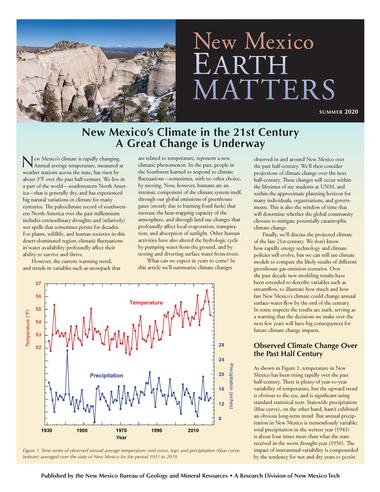
New Mexico Earth Matters — Back-issues

Vol. 20, No. 2, Summer 2020 4.99 MB
New Mexico’s Climate in the 21st Century: A Great Change is Underway
— David Gutzler
— David Gutzler
New Mexico’s climate is rapidly changing. Annual average temperature, measured at weather stations across the state, has risen by about 3oF over the past half-century. We live in a part of the world—southwestern North America—that is generally dry, and has experienced big natural variations in climate for many centuries. The paleoclimate record of southwestern North America over the past millennium includes extraordinary droughts and (relatively) wet spells that sometimes persist for decades. For plants, wildlife, and human societies in this desert-dominated region, climatic fluctuations in water availability profoundly affect their ability to survive and thrive.
However, the current warming trend, and trends in variables such as snowpack that are related to temperature, represent a new climatic phenomenon. In the past, people in the Southwest learned to respond to climate fluctuations—sometimes, with no other choice, by moving. Now, however, humans are an intrinsic component of the climate system itself, through our global emissions of greenhouse gases (mostly due to burning fossil fuels) that increase the heat-trapping capacity of the atmosphere, and through land use changes that profoundly affect local evaporation, transpiration, and absorption of sunlight. Other human activities have also altered the hydrologic cycle by pumping water from the ground, and by storing and diverting surface water from rivers.
What can we expect in years to come? In this article we’ll summarize climate changes observed in and around New Mexico over the past half-century. We’ll then consider projections of climate change over the next half-century. These changes will occur within the lifetimes of my students at UNM, and within the approximate planning horizon for many individuals, organizations, and governments. This is also the window of time that will determine whether the global community chooses to mitigate potentially catastrophic climate change.
Finally, we’ll discuss the projected climate of the late 21st century. We don’t know how rapidly energy technology and climate policies will evolve, but we can still use climate models to compare the likely results of different greenhouse gas emission scenarios. Over the past decade new modeling results have been extended to describe variables such as streamflow, to illustrate how much and how fast New Mexico’s climate could change annual surface-water flow by the end of the century. In some respects the results are stark, serving as a warning that the decisions we make over the next few years will have big consequences for future climate change impacts.


